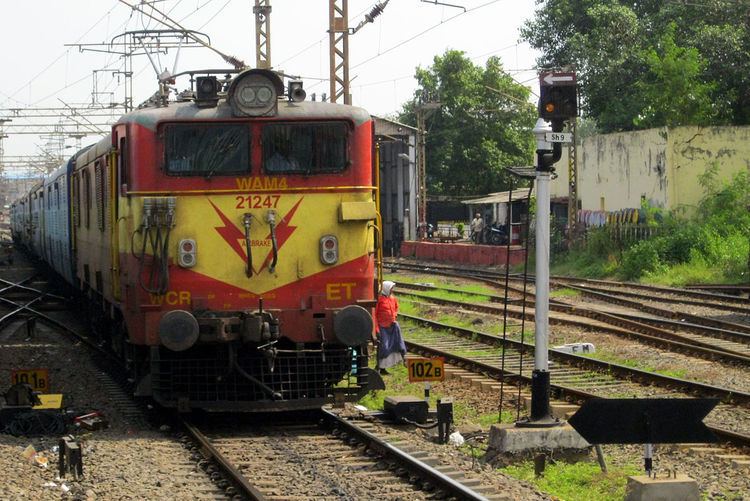Power type Electric Rebuild date 1978-1983 to WAG-5 Gauge 5 ft 6 in (1,676 mm) | Build date 1970-1983 UIC class Co′Co′ | |
 | ||
Builder | ||
The Indian locomotive class WAM - 4 is a very successful class of 25 kV AC electric locomotives used in India. The first member of the class was indigenously designed and built by CLW in 1970. The class was produced until 1983.
The locomotives in the class feature rheostatic braking, and MU capability. They use the same power bogies as the successful WDM-2 class of diesel-electric locomotives. Being designed specially for mixed traffic, the WAM-4 class has rendered excellent service. Now, most of these are used exclusively for passenger traffic. This class proved so successful by virtue of its ruggedness suitable for Indian conditions and simplicity of maintenance, that IR used this basic design for a number of other locos later (WCAM-1, WAG-5., WCG-2, and some WAP models). The WAM-4 loco is still among the most heavily used electric locos of IR. A single WAM-4 can generally haul up to a 24-coach passenger rake.
This loco class has been seen in many variations, as a lot of workshops and sheds have carried out their own enhancements or modifications to the basic loco design. This loco has the widest variety of liveries, with each loco shed having its own livery. Although the code indicates a mixed-use loco, most WAM-4's ended up hauling passenger trains. They have been used for regularly hauling freight only in a few locations (Arakkonam - Renigunta, Kirandul-Kottavalasa and other SER sections). Max. speed 110 km/h.Variants include WAM-4P D (dual brakes), WAM-4P R (??), WAM-4P DB 6P, WAM-4 6P DB HS, and WAM-4 6P D (these are for superfast trains), WAM-4P DB 3P and WAM-4 2S-3P (some superfasts, passengers), and WAM-4P DB 4P (generally for stopping passengers). The 'DB' or 'D' generally, but perhaps not always, indicates dual-brake capability. 'HS' may be for 'high speed'.'2S', '3P', '6P', etc. indicate traction motors connected in series or parallel. The WAM-4 has six traction motors, and originally they were wired to be available in different configurations at different power settings. At notches up to 14, all motors were in series (at notch 14 all resistors dropping out); up to notch 21 in series-parallel combinations (three pairs of motors in series, the pairs themselves being in parallel); and further notches with all motors in parallel (at notch 30 all motors are in parallel with resistors dropping out). This is the original configuration of the WCAM-x series of locos too. The WAM-4 locos were later reconfigured to have all motors always in parallel (6P variants) or with the three series-connected pairs in parallel (2S 3P variants). Some WAM-4 locos from CLW are thought to have had the 2S 3P configuration right from the start. The 2S 3P configuration was better for the mixed traffic loads especially as it allowed the locos to start hauling larger loads without stalling. With increasing use of the WAM-4 locos for passenger traffic the all-parallel configuration was deemed more desirable since it allowed higher speeds and higher acceleration.
Most of the WAM-4 locos now have their MU capability disabled as RDSO disapproves of these locos running MU'd over 100 km/h.
Some of the sheds holding WAM 4 locomotives
- Arakkonam (AJJ)
- Asansol (ASN)
- Bhilai (BIA)
- Bhusaval (BSL)
- Itarsi (ET)
- Mughalsarai (MGS)
- Tatanagar (TATA)
- Tughlakabad (TKD)
- Valsad (BL)
- Vijayawada (BZA)
- Visakhapatnam (VSKP)
- Vadodara (BRC)
